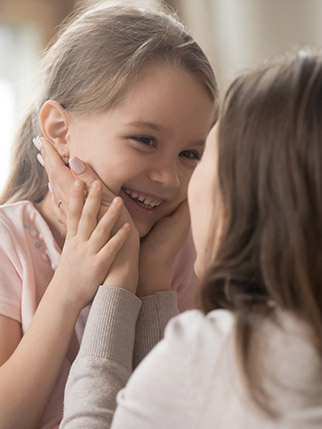When should I schedule my child’s first dentist visit?
We recommend that you make an appointment to see the dentist as soon as your child gets their first tooth. The American Academy of Pediatric Dentistry recommends that children be seen by six months after their first tooth erupts, or at one year of age, whichever comes first.
Much like your own permanent teeth, your child’s primary teeth require professional and at-home dental care. Decay can happen at any age, so it’s time to visit the dentist within six months of your child’s first tooth appearing, and certainly by age one. In addition to checking for tooth decay and other pediatric dental problems, your dentist will show you the best ways to start your child on a lifetime of good oral health habits.
What happens during my child’s first visit to the dentist?
Our practice is committed to providing you and your family with safe, gentle, high-quality dental care. We understand that your child may feel anxious about visiting the dentist. We are sensitive to children’s needs and it is our goal to make your child feel comfortable visiting our practice while providing the best care possible.
The first visit is usually short and simple. In most cases, we focus on getting to know your child and giving you some basic information about dental care. The doctor will check your child’s teeth for placement and health, and will look for any potential problems with the gums and jaw. If necessary, we may do a bit of cleaning. We will also answer any questions you have about how to care for your child’s teeth as they develop, and provide you with materials containing helpful tips that you can refer to at home.
How can I prepare my child for their first dental appointment?
The best preparation for your child’s first visit to our office is maintaining a positive attitude. Children pick up on adults’ apprehensions, and if you make negative comments about trips to the dentist you can be sure that your child will fear an unpleasant experience and act accordingly. Read a book about going to the dentist or show your child pictures of the office and staff on the website. Let your child know that it’s important to keep their teeth and gums healthy, and that the doctor will help do that. Remember that your dentist is specially trained to handle fears and anxiety, and our staff excels at putting children at ease during treatment.
How often should my child visit the dentist?
We generally recommend scheduling checkups every six months. Depending on the circumstances of your child’s oral health, we may recommend more frequent visits.
Baby teeth aren’t permanent. Why do they need special care?
Although they don’t last as long as permanent teeth, your child’s first teeth play an important role in development. While they’re in place, these primary teeth help your little one speak, smile, and chew properly. They also hold space in the jaw for permanent teeth. If a child loses a tooth too early (due to damage or decay) nearby teeth may encroach on that space, which can result in crooked or misplaced permanent teeth. Also, your child’s general health is affected by the oral health of the teeth and gums.
In addition to the pain caused by a primary tooth cavity, young children can develop dental infections. Primary tooth decay is a serious, infectious, and transmissible disease that can spread quickly and lead to infection or abscess without proper precautions. This can be especially harmful to children because their immune systems aren’t fully developed.
The most important aspect of taking care of your child’s primary teeth is the example you help to set of taking oral health seriously. Early on, your child should develop the habit of brushing and flossing that will carry into adulthood. Healthy teeth also lead to easier dental visits, teaching your child that there is nothing to be afraid of at the dentist.
What’s the best way to clean my baby’s teeth?
Even before your baby’s first tooth appears, we recommend you clean the gums after feedings with a damp, soft washcloth. As soon as the first tooth appears, you can start using a toothbrush. Choose a toothbrush with soft nylon bristles and a small head. You can find a toothbrush designed for infants at your local drugstore or online.
Once your child has a few teeth, you can start using toothpaste on the brush. Use only a tiny amount of fluoridated toothpaste (the size of a grain of rice) for each cleaning. Once they are able to spit (typically sometime after 2-4 years old) you can increase the toothpaste amount to the size of a green pea. Once you transition to a pea-size amount, always have your child spit out the toothpaste after brushing. Children naturally want to swallow toothpaste after brushing, and swallowing too much fluoride toothpaste can cause teeth to stain. You should brush your child’s teeth until they are ready to take on that responsibility, which usually happens by age six or seven.





